2022 IPM Program contacts:
IPM Program Coordinator
Mary Concklin
860-486-6449
mary.concklin@uconn.edu
Diagnostics
Nick Goltz
860-486-6740
nick.goltz@uconn.edu
Fruit IPM
Mary Concklin
860-486-6449
mary.concklin@uconn.edu
Greenhouse IPM
Leanne Pundt
860-626-6855
leanne.pundt@uconn.edu
Rosa Raudales
860-486-6043
rosa.raudales@uconn.edu
Hemp Program
Shuresh Ghimire
860-875-3331
shuresh.ghimire@uconn.edu
Invasive Species IPM, Pesticide Safety Education, Pollinator Program, School IPM, and Turf & Landscape IPM
Victoria Wallace
860-885-2826
victoria.wallace@uconn.edu
Vegetable IPM
Shuresh Ghimire
860-875-3331
shuresh.ghimire@uconn.edu
Ana Legrand
860-486-0869
ana.legrand@uconn.edu
This report was edited by Mary Concklin, IPM Program Coordinator.
CONNECTICUT INTEGRATED PEST MANAGEMENT PROGRAM
2022 Annual Report
Introduction
The Integrated Pest Management (IPM) Program is a collaboration between UConn Extension and the Department of Plant Science & Landscape Architecture. Since its inception in 1980, the UConn IPM Program has made great strides in developing and implementing sustainable methods for pest control throughout Connecticut. Integrated Pest Management applies multiple tactics in a variety of settings through the selection of appropriate tools and the education of agricultural industry members and Connecticut citizens to provide sustainable, science-based approaches for the management of plant pests (insects, mites, diseases, wildlife, and weeds, including invasive plants). The UConn IPM Program incorporates all possible crop management and pest management strategies through knowledgeable decision-making, utilizing the most efficient landscape and on-farm resources, and integrating cultural and biological controls. Program objectives include maintaining the economic viability of agricultural and green industry businesses, enhancing and conserving environmental quality and natural resources, educating participants on the effective use of cultural practices to mitigate pest problems, of biological control agents, and educating pesticide users about bee and other pollinator safe materials, least toxic options, and the safe use and handling of organic and synthetic pesticide products. The 2022 IPM Program Team included Mary Concklin (fruit and IPM Coordinator), Shuresh Ghimire (vegetables and hemp), Rosa Raudales, Leanne Pundt and Carla Caballero (greenhouse), Victoria Wallace (school, invasive, pesticide safety, pollinators, turf and landscape), Ana Legrand (vegetable entomology), and Nick Goltz (diagnostician).
The goal of IPM is to reduce the dependence of agricultural producers and green industry professionals, Connecticut citizens, and schools on pesticides while maintaining or improving productivity, crop quality, and quality of life. The IPM Program has educated growers statewide about the judicious and safe use of organic and synthetic pesticides and alternative pest control methods.
Broader adoption of IPM practices enhances responsible pest management and reduced management and production costs; minimizes adverse environmental and economic effects from pests and pest management; results in improved ecosystem quality and plant performance; and improves plant health, quality, yields, and aesthetics. The use of IPM includes cultural controls; biological control agents; biological fungicides; physical and mechanical controls; the use of resistant cultivars; regulatory controls; behavioral modification; and, only, when necessary, chemical controls, with the selection of least toxic products. IPM partners and collaborators include State and Federal agricultural and environmental/non-governmental agencies and organizations; State, New England, and Northeastern fruit, greenhouse, grounds keepers, nursery, turf, landscape, and vegetable associations; industry suppliers/dealers; regional universities; educators; schools and municipalities; individual growers, farmers, and producers; Master Gardeners; and the general public.
COVID-19 had less of an impact on our outreach programs than in the two previous years. We were able to conduct many in-person programs while continuing to offer many virtual programs. IPM Program team members conduct intensive on-site educational training for fruit and vegetable producers, garden center owners, greenhouse growers, nursery producers and retailers, and turf and landscape professionals. Growers and green industry professionals receive information on the current status of and recommendations for important plant pests and training via pest messages, email alerts, webinars, newsletters, articles in national trade journals, management guides, websites, social media, consultations and counseling via phone and text, site visits to their operations, workshops, field demonstrations and research projects, conferences, exhibits, and short courses. IPM programs are evaluated through pre- and/or post program surveys and evaluations, needs assessment surveys, testimonials, and unsolicited comments.
IPM Outcomes
Fruit integrated pest management education was delivered to over 571 fruit growers and related industry members throughout 2022 through 62 fruit e-newsletters and pest alert emails.
Vegetable integrated pest management education was delivered to over 500 vegetable growers and stakeholders every week from May to September 2022 through 19 weekly vegetable pest alert emails focusing on pests, pest management and decision making, and safe pesticide use. The email open rate was 25-30%.
Sixty-three students enrolled in our online Vegetable Production Certificate course in the winter of 2022. The course had seven modules, each module with a self-paced video, supplemental materials, and a short quiz. In the post-course evaluation survey (N = 63, n = 20), respondents indicated their knowledge on the subjects increased from average of 43% before the course to 86% after the course.
The Greenhouse Biological Control conference had 63 attendees. 92% of attendees stated that they learned something to cause them to adopt a new practice within the next year.
Over 300 invasive plant activities occurred in over 50 Connecticut towns in 2022. At least 5,017 citizens directly and actively participated in the activities. Many more (at least 7,185) were reached indirectly through articles, YouTube videos, social media, fact sheets, signs, and other educational mediums. A minimum of 15,302 hours were directly invested in invasive plant management, during intensive invasive plant training sessions and management activities, as well as educational outreach. A minimum of 904 hours were provided indirectly as citizens engaged in educational efforts and learned from videos, articles, and fact sheets.
The eleventh biennial Connecticut Invasive Plant Working Group (CIPWG) symposium was convened via web program on November 3, 2022, with 420 people attending. The symposium theme was Strategies for Managing Invasive Plants: Assess, Remove, Replace, and Restore.
There were 65,382 sessions created by 36,422 users of the IPM website (ipm.cahnr.uconn.edu) during 2022. Users include residents of Connecticut plus CA, GA, IL, MA, NY, TX, VA, WA, WY and Washington DC, as well as 167 other countries with the top 10 being India, Canada, Philippines, China, Australia, United Kingdom, South Korea, Mexico, South Africa and Kenya.
IPM Program Funding
The Connecticut IPM Program is a collaboration between UConn Extension and the UConn Department of Plant Science & Landscape Architecture in the UConn College of Agriculture, Health & Natural Resources. The IPM Program Team acknowledges support from the following Federal, State, and private funding sources: Connecticut Department of Agriculture
Connecticut Department of Energy and Environmental Protection (DEEP)
Connecticut Farm Bureau
Connecticut School IPM Coalition
Grower donors and municipal and school grounds research participants throughout Connecticut Indian Land Tenure Foundation (ILTF)
Multi-state Hatch Project NE-1032
National Plant Diagnostic Network (NPDN)
New England Vegetable & Berry Growers’ Association
Northeastern IPM Center (NEIPMC)
Northeast Organic Farming Association of Connecticut (NOFA)
Northeast Sustainable Agriculture Research and Education Program (SARE)
Rose Mill Company, Hartford, Connecticut
The Connecticut Agricultural Experiment Station (CAES)
The University of Connecticut
The University of Connecticut Innovative Programming in Extension grant
The University of Connecticut Research Excellence Program, Office of the Vice-president for Research US Department of Agriculture (USDA) Animal and Plant Health Inspection Service (APHIS) USDA Agriculture and Food Research Initiative Education and Literacy Initiative (AFRI ELI) USDA Extension Risk Management Education Program (ERME)
USDA Federally Recognized Tribes Extension Program (FRTEP)
USDA National Institute of Food and Agriculture (NIFA) Beginning Farmer and Rancher Development Program (BFRDP)
USDA NRCS Conservation Innovation Grants (CIG)
USDA NIFA Crop Protection and Pest Management (CPPM) Extension Implementation Program (EIP) USDA NIFA New Beginning for Tribal Students (NBTS)
USDA NIFA Specialty Crop Research Initiative (SCRI) project
USDA Northeast Region IR-4 Program
USDA Northeast Sustainable Agriculture Research & Education (SARE) Program
USDA Risk Management Agency (RMA)
USDA Specialty Crop Block Grant (SCBG) Program
UConn IPM Program Team Delivers Educational Outreach
Vegetable IPM
Program Leader: Dr. Shuresh Ghimire, Assistant Extension Educator
Vegetable Twilight Meeting at Cold Spring Brook Farm, Berlin, CT
Wednesday, September 21, 2022- 5:00 pm
UConn Extension conducted a twilight meeting for vegetable growers. Eric Peterson and Steve Bengtson at Cold Spring Brook Farm hosted a twilight meeting to cover high tunnel fertility management and biodegradable plastic mulch. Dr. Rebecca Brown, professor in the Department of Plant Sciences and Entomology at the University of Rhode Island, presented about optimization of fertility and cultivar selection for high tunnels, with particular emphasis on management of heat stress. Field culture methods can be used to grow tomatoes in high tunnels but often fail to maximize the potential of high value tunnel space. Dr. Josef Görres, Associate Professor and soil scientist at the University of Vermont presented about modeling effort to understand the cycling, mineralization, and movement of nitrogen and phosphorus in high tunnel soils. Dr. Shuresh Ghimire, Extension Vegetable Specialist at UConn Extension provided an update on the use of biodegradable plastic mulch for vegetable production and showcased a demonstration plot of biodegradable plastic mulch at the farm where tomatoes were grown. Twenty growers and stakeholders participated in the meeting. The meeting was recorded and was posted on ipm.cahnr.uconn.edu along with the hands-out.
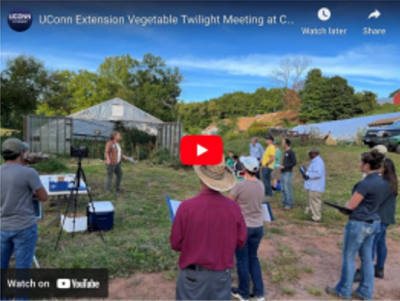
2022 UConn Extension Vegetable Production Certificate Course
Sixty-three students enrolled in the UConn Extension online Vegetable Production Certificate course in the winter of 2022. The course had seven online modules, each module with a self-paced video, supplemental materials, and a short quiz. This course was designed to benefit beginner vegetable producers with 0-3 years of vegetable growing experience or no formal training in agriculture. The participants learned answers to the basic questions about farm business planning, planning and preparing for vegetable farm, warm and cool season vegetable production techniques, season extension, identification of biotic and abiotic issues, and marketing. In the post-course evaluation survey (total number of course participants = 63, number of respondents = 20), respondents indicated their knowledge on the subjects increased from average of 43% before the course to 86% after the course.
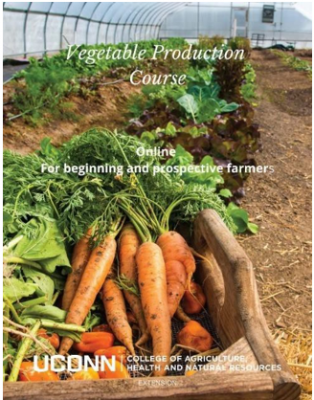
Comments from participants
“Thank you so much for offering this course at such an affordable price and making it something I can work into my busy schedule- very well done!”
“This was a great, informative course! Thank you for providing this to those who are interested.”
“Appreciated hearing from the farmers in addition to the UConn staff/scientists.”
Federally Recognized Tribes Extension Program (FRTEP) with Mashantucket Pequot Tribal Nation
UConn Team Members: Shuresh Ghimire (April 2019-present), Mary Concklin (2017-April 2019), Joseph Bonelli, Robert Ricard (2021-present), Miriah Kelly (2017-August 2020), Michael Puglisi, Pam Gray, Erica Benvenuti, Sara Tomis (2022 May-present), Jiff Martin (September 2022-present) and Indu Upadhyaya (September 2022-present). Funding: FRTEP Awards 2017-41580-26950 and 2022-41580-37944.
UConn Extension received a FRTEP grant in 2017 for the first time. The main goals of the project were to improve food security in the MPTN, engage Tribal youth, boost the economic viability of the Tribe’s agricultural enterprises, and educate Tribal members about nutrition and health. Since the start of the UConn FRTEP, UConn Extension educators and staff have been working extensively with the MPTN and providing training to achieve the project goals.
Before the start of the FRTEP grant in 2017, 1.5 acres was cultivated on the reservation. In 2022, 10 acres was cultivated. Since 2017, five households have started backyard gardening, and a school garden has been established and maintained by program participants. Jeremy Whipple, the Executive Director of the Tribal Department of Agriculture attributed this change to the FRTEP grant: “Before 2017, no one was thinking that farm was going to benefit the Tribe. Gardening was basically a hobby. Since the FRTEP grant started, we employed people to grow crops, harvest more maple syrup, generated a lot more income, and started doing events that got people’s attention.” Jeremy also reported, “before the start of the grant, the revenue was $5,000 per year, all of it from maple syrup.” In 2021, the gross revenue was $78,000, of which $70,000 was from maple syrup and $8,000 from vegetables grown at meechooôk farm, the tribal farm built with the help of this grant. A farm stand was started in the spring of 2022 and is operational since then. The farm produce and products have also been sold at local supermarkets. The farm has created and used a farm logo to market and brand farm products. Jeremy added, “There has been significant growth in agricultural production, food security, and health for the members of the nation since the start of the UConn FRTEP. Building on this success, we have recently created the Mashantucket Pequot Tribal Nation Department of Agriculture. Our MPTN Department of Agriculture formalizes the education, nutrition, and farming work previously done in collaboration with UConn Extension.” With the help of the FRTEP grant, meechooôk farm is now equipped to scale up its production and sales.
Since the start of the grant, Tribal youth have been engaged through cooking/nutritional workshops offered by UConn Extension nutrition educators. A fitness class for youth as well as a youth-led marketing campaign for the MPTN farm produce was completed. When in-person interactions were limited due to the COVID-19 pandemic, a series of virtual cooking classes were held from 2020 through 2022. On average, the number of participants in those virtual classes was 20 (highest 55). Youth, their parents, grandparents, aunts, uncles, and friends participated in those classes. Turkey chowder and stuffing cups, quesadillas and salsa, impossible cheeseburger pie and blueberry slump, apple hand pies, Shepard’s pie, and cinnamon swirl pancakes with turkey breakfast sausage were some of the recipes demonstrated in the class.
MPTN has leveraged infrastructures and relationships built through FRTEP to secure funding from other agencies. Jeremy Whipple highlighted in an interview the broader impact of the grant, “What the FRTEP grant has done for the Tribal community and all departments is make them more aware of the positive effects of farming can have for the community and Tribal departments. For example, our IHS [Indian Health Service] got a grant for diabetic patients to eat fresh vegetables as a prescription.” Additionally, the MPTN has received funding from Natural Resource Conservation Service to build 4 high tunnels at their farm. They have also received funding from the Native American Agricultural Fund to support their agricultural enterprise.
Daniel Menihan, an MPTN Councilor in an interview said, “The partnership with UConn has made the Tribe stronger. It definitely refocused our attention toward farming and healthier eating. Since day 1, we positioned UConn and the Tribal nation as partners, both having a say in the direction that we go in and being able to rely on one another.” Another Tribal member added, “There are efforts within the Tribe to show our commitment and do our part to support this [FRTEP] program. We want to show the Tribe’s commitment as well as not having to rely solely on UConn. We’ve gotten a great deal from UConn.”
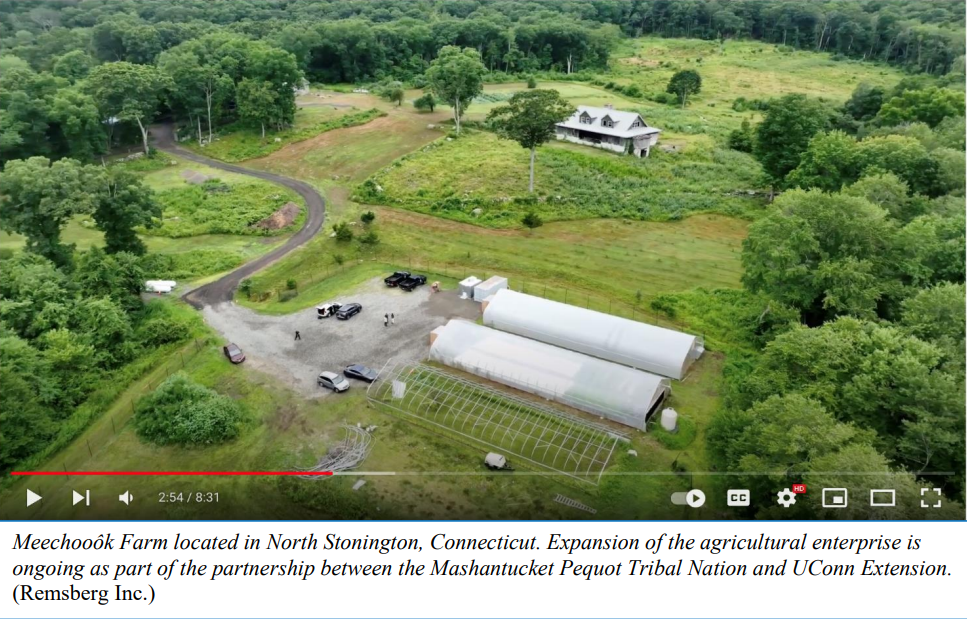
ongoing as part of the partnership between the Mashantucket Pequot Tribal Nation and UConn Extension.
(Remsberg Inc.)
In summary, the UConn FRTEP project has aided in the development of a strong partnership between members of UConn and members of the MPTN. UConn Extension has worked collaboratively with many members of the Tribal community in many areas, including food production, youth development through 4-H programs, and Tribal health and nutrition. In the listening session, a member of the MPTN Tribe highlighted the value of the existing relationship with UConn and a need for continued collaboration, “This [FRTEP] grant has been a huge jumpstart for the [MPTN] community because what better can you do than provide healthy food for your community and your people as indigenous people as a whole suffer from high rates of diabetes and high blood pressure.”
Weekly Pest Alert
Vegetable integrated pest management education was delivered to over 500 vegetable growers and stakeholders every week from May to September 2022 through 19 weekly vegetable pest alert emails focusing on pests, pest management and decision making, and safe pesticide use. The email open rate was 25-30%.
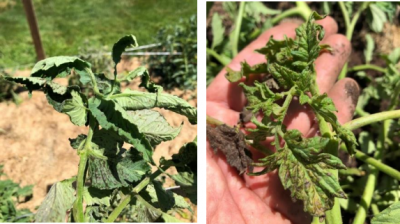
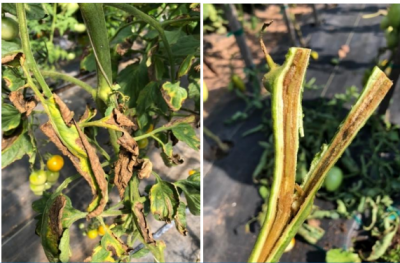
necrosis develops as a result of bacterial canker. Photos: S. Ghimire
New England Vegetable and Fruit Conference
December 13,14, and 15, 2022. Manchester, New Hampshire
UConn Extension was a co-organizer of 2022 New England Vegetable and Fruit Conference along with Cooperative Extension Systems from UMass, URI, UNH, UMaine, UVM, Cornell, as well as three growers’ associations (New England Vegetable and Berry Growers, Massachusetts Fruit Growers, and Maine Organic Farmers and Gardeners). Shuresh Ghimire from UConn Extension served as the Registration Chair for the conference. This conference welcomed 1460 participants and 137 trade show exhibitors. While most participants were from New England (including 75 from Connecticut) and New York, 18 participants came from 8 other US states and 13 participants from Canada. This conference included 33 educational sessions over three days, covering major vegetable, berry and tree fruit crops as well as various special topics. A Farmer-to-Farmer meeting after each morning and afternoon session brought speakers and farmers together for informal, in-depth discussion on certain issues.
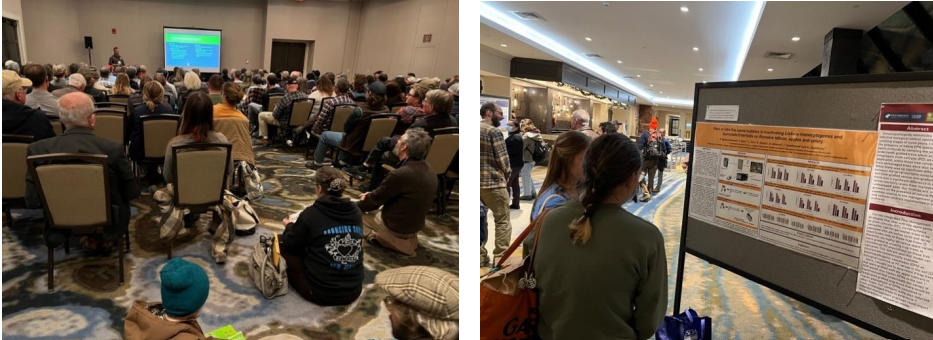
Dec 14, 2022.
In June of 2022, UConn Extension partnered with CT Resource Conservation and Development, USDA NRCS, Connecticut Department of Agriculture, and Connecticut Hemp Industry Association to organize the 2022 Connecticut Hemp Fest at Running Brook Farms, Killingworth, CT. The goal of the event was to bring together growers, service providers, and businesses interested in the hemp industry for an educational and networking event. The educational portion included farmer panel discussions covering Hemp IPM, moderated by Shuresh Ghimire, UConn, as well as reduced tillage for plant growth and soil health, moderated by James Hyde, NRCS. The event also included updates from the field & greenhouse with a hemp tour at Running Brook Farm. The second half of the event included a Seed Swap and Clone Sale, and a chance to connect while listening to live music. The event was attended by 80 current and prospective hemp growers and stakeholder and 23 vendors and exhibitors. This event provided valuable resources for local producers seeking to make connections, gain knowledge, and connect with the Hemp community.
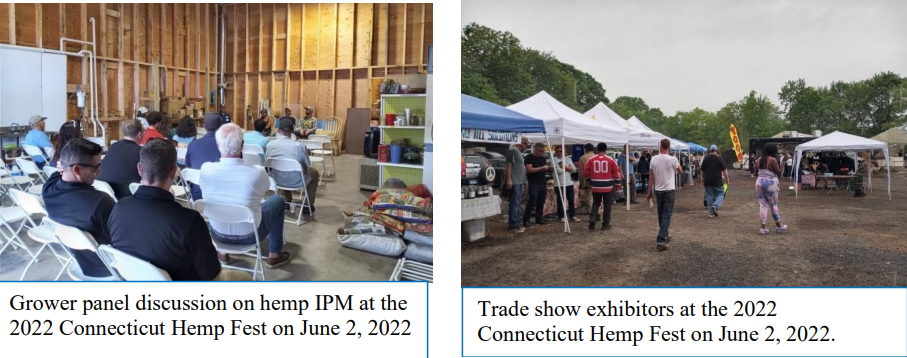
Comments from an attendee:
“Learning good pest protection/prevention is very beneficial as I plan to grow hemp starting this summer.”
Fruit Production and IPM
Program Leader: Mary Concklin, Extension Educator and IPM Program Coordinator
Drone Imagery for Early Detection of Fruit Crop Nutritional Deficiencies This project is identifying and quantifying nutrient deficiencies in perennial fruit crops (grapes, blueberries, apples and peaches) using drone imagery with the goal of making necessary nutrient corrections in time to impact the present crop. Models have been developed for detecting plant nutrient deficiencies in fruit crops using drone images (NDVI, NDRE indices) and Pearson’s Correlation Coefficient. Researchers conducted 15 drone flights at 3 CT orchards during 2020 through 2022 growing seasons, and tested 165 tissue samples for nutrient deficiency correlations in grapes, blueberries, apples and peaches. At the project’s conclusion, it was possible to correlate the drone imagery with tissue results to develop 62 models. Another grant will allow the researchers to validate the models as well as to determine economics of this system. A storymap was developed for this project with the UConn CLEAR team. It can be viewed at s.uconn.edu/IPMdrones.
Team: Mary Concklin, Evan Lentz – graduate student, Dr. Chandi Witharana, Assistant Professor, Remote Sensing. Growers: Belltown Hill Orchards, S. Glastonbury, Rogers Orchards, Southington, and Blue Hills Orchard, Wallingford. Funding provided by USDA Specialty Crop Block Grant through the CT Department of Agriculture.
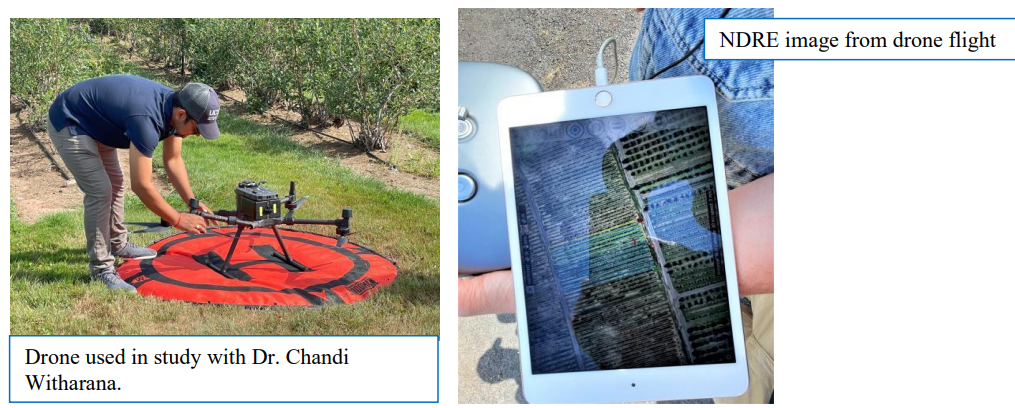
Fruit On-Farm IPM Training was conducted with 2 farms in 2022. The number is less than in previous years because M. Concklin was working part-time. On-site, phone, email and texts were used. The training involved key pests and beneficials of tree fruit and berry crops, insect pest and plant pathogen life cycles, economic thresholds, and IPM management strategies including biologicals.
Brown Marmorated Stinkbug monitoring was conducted on 4 commercial fruit farms across CT. Traps were monitored weekly and management recommendations provided when needed. Over the past 2 years the number of BMSB in orchards has decreased leading us to suspect the presence of a natural predator, specifically the Samurai wasp, Trissolcus japonicus. Scouting was done to find BMSB egg masses to confirm this, but none were found.
Risk Management Education Partner Program
We partnered with the USDA Risk Management Agency and USDA Farm Service Agency for 4 live virtual and recorded crop insurance programs to explain programs offered to growers and livestock farmers in CT. Closed captioning is in Spanish. Updates are important to keep growers informed of any changes to policies, as well as new policies. Videos can be viewed at the UConn Farm Risk Management website at ctfarmrisk.extension.uconn.edu
Team: Mary Concklin and Joseph Bonelli, Associate Extension Educator, Farm Business Management. Funding provided by USDA Risk Management Agency (RMA).

New England Winter Fruit Seminar Series hosted by the Fruit Extension Educators in each of the NE states. These seminars occurred weekly at the lunch hour from January through March 2022, with pesticide update credits provided at most. Topics ranged from updates on tree fruit and small fruit cultural practices and pest issues. Attendees ranged from 75 to 125 each week.
CT Pomological Society Annual Meeting, November 29, 2022, Middletown Elks Lodge M. Concklin was the program chair for this annual meeting. Speakers covered topics including biological control of fruit pests, cold hardy peaches, invasive insects & management, controlling plum curculio with grafted trees, Hazel for storage, and weed management. 120 growers and industry members attended including 14 exhibitors.
Fruit Message: 62 fruit messages were emailed to 571 fruit growers and industry members in 2022 covering pest information, management strategies, cultural practices, meetings and educational programs. Most of the messages are available at the IPM website (ipm.cahnr.uconn.edu).
Greenhouse IPM
Program Leaders: Leanne Pundt, Extension Educator
Dr. Rosa Raudales, Associate Professor of Horticulture & Greenhouse Extension Specialist Carla Caballero, Greenhouse Spanish Trainer
University of Connecticut Supports Connecticut’s Greenhouse Industry, An Integral Part of Agriculture
Greenhouses in Connecticut represent over one third of the state’s vibrant $4.7 billion agricultural economy and are integral to the success of all agricultural businesses, according to a 2021 study by Farm Credit East. The total economic impact of the 583 greenhouse businesses in the state was $390 million in 2020. With support from NIFA, researchers and educators from UConn Extension within the College of Agriculture, Health and Natural Resources (CAHNR) support greenhouse businesses in greenhouse production, water conservation, integrated pest management and innovative technology.
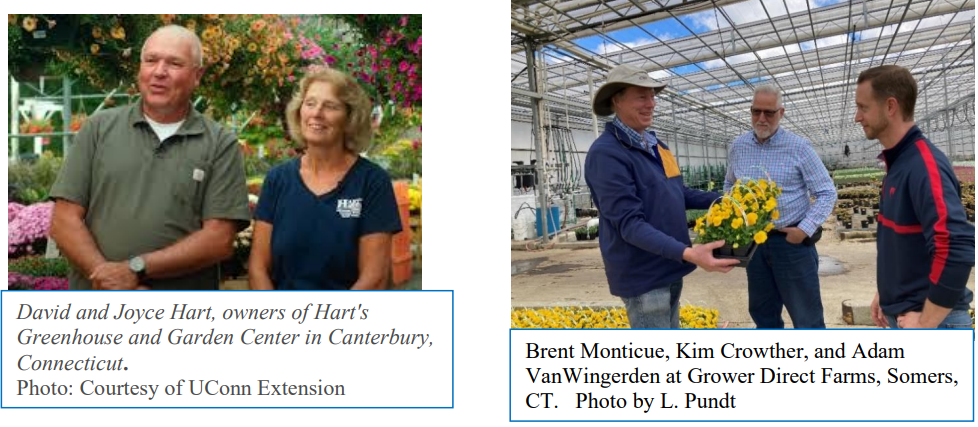
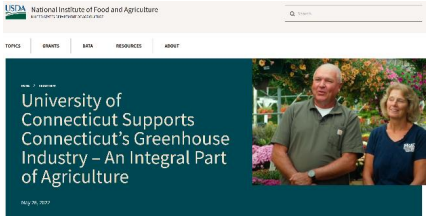
https://www.youtube.com/watch?v=qW9EtcrRA-Q which was
featured in USDA NIFA’s website:
https://www.nifa.usda.gov/about-nifa/impacts/universityconnecticut-supports-connecticuts-greenhouse-industry-integralpar
Consultations to members of commercial greenhouse industry
148 visits conducted from January through November by Leanne Pundt.
Nine one-on-one visits conducted by Carla Caballero to greenhouses and nurseries to provide individual consultations about plant production, interview workers on training, and collect footage and photos for education materials. Provided technical assistance to growers and collected plant or substrate samples to diagnose the cause of growth abnormality. Interview Spanish-speaking workers to gather information about specific needs on education in greenhouse production to develop educational materials in Spanish.
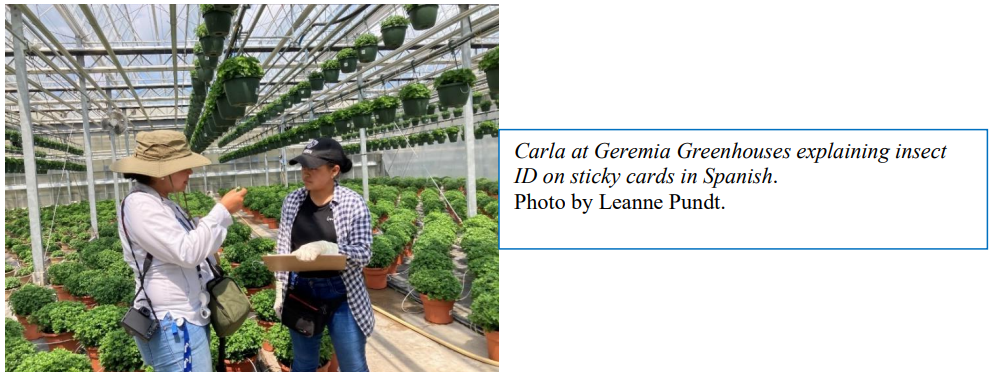
Greenhouse Biological Control Conference
A full day conference was held on August 16, 2022 at the CT Agricultural Experiment Station in New Haven, CT. Topics presented included: Update on Banker Plants, Releasing Natural Enemies, Tips on How to Effectively Integrate Biological and Chemical Controls, Enhancing the Use of Biological Fungicides in a Biologically Based IPM Program, and Grower Case Studies, What’s Working?
The conference was attended by 63 with attendees from CT, MA and VT Of those that completed evaluation forms, 99% rated the conference as useful to very useful, 97.5% currently use biological controls (beneficial insects, biological fungicides or beneficial nematodes), 92% stated that they learned something to cause them to adopt a new practice within the next year.
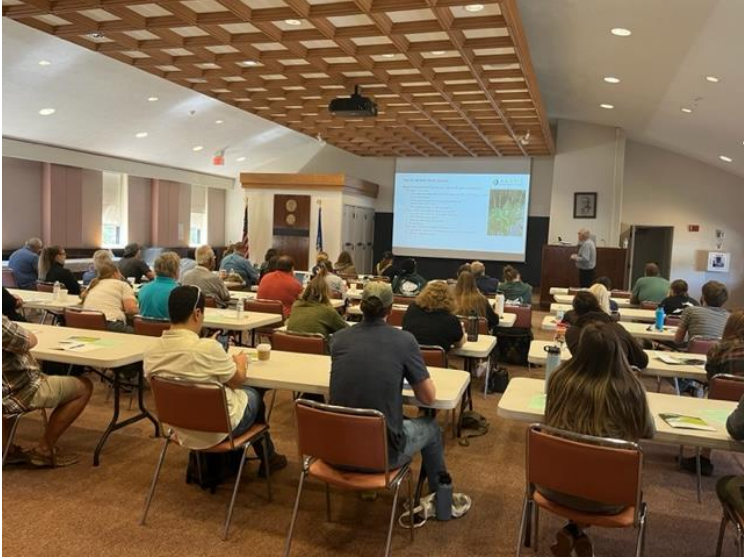
Greenhouse Pest Messages posted on Greenhouse IPM website and send to over 270 members of the greenhouse industry via email.
Webinars for Spanish-Speaking Workers in the Green Industry, 19 October 2022. Topics presented included: How to irrigate containers and Diagnostics of plant diseases and Disorders. The participants that completed the webinar poll indicated to have an intermedia level of knowledge in plant diagnostic and container irrigation (59% and 42 % respectively), 99% responded feeling more prepare to irrigate container and to diagnose plant deceases in the greenhouse after the program.
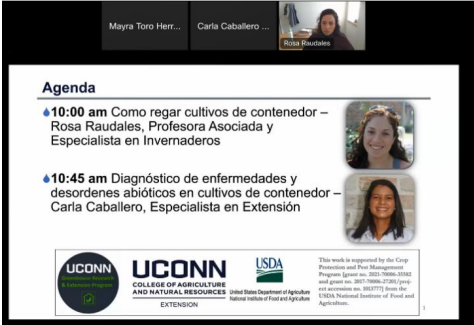
Program comments include
Muy buena información, yo estoy aprendiendo y esta información me sirve mucho, gracias. (Very good information, I am learning, and this information helps me a lot, thank you)
Hola mi nombre es Nohemi, me encantó aprender, muy buenos consejos los aplicaré de hoy en adelante, muchas gracias es una información muy importante. (Hello, my name is Nohemi, I loved to learn, very good advice I will apply them from now on, thank you very much is a very important information).
Me gustó su programa (I liked the program).
“Educational Needs of the Spanish speaking Workforce in the Green Industry in CT” in English and Spanish (IRB # X22-0142) surveys were developed and completed. Respondents indicated that identification and monitoring of Insect and mite pests (55%), Irrigation (50%) and identification and monitoring of root diseases (45%), as the top three subjects where they would like more training. Seventy three percent of the respondents indicated that having the information only in English as a factor limiting the participation of the Spanish-speaking workforce to extension trainings programs. Among other questions, respondents indicated their learning preferences and accessibility limitations.
Created training videos in Spanish and English and uploaded to the UConn Greenhouse Channel https://www.youtube.com/channel/UCJbcMQSF8bqpuzNjGUPweTw
- Starting a biological control program for greenhouse insect and mite pests. https://youtu.be/ofJ8fPBqBF0
- Scouting whiteflies in poinsettias. https://youtu.be/GdwDYIcB5H0
- Identifying some pests on sticky cards in greenhouses. https://youtu.be/g4q5jNPS-4s This video was featured as Video of the week on December 23, 2022, in Greenhouse Grower Magazine —a nationwide magazine with a readership of >20K. greenhousegrower.com
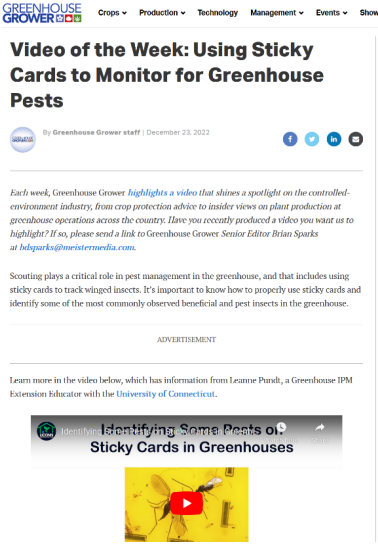
Comments from attendees
Great job Leanne, Rosa, Alvaro, and friends
Very nice conference, knowledgeable presenters
Excellent data, engaging
Translations:
Translated 18 Greenhouse Pest Messages written by Leanne Pundt from English to Spanish and posted on the UConn IPM website https://ipm.cahnr.uconn.edu/spanish-resources.
- Almacenamiento de plaguicidas y mantenimiento de registros, 2 de diciembre, 2022.
- Prevención de Botrytis en Poinsettias, 27 de octubre, 2022.
- Consejos para limpiar invernaderos vacíos entre ciclos de producción, 21 de octubre, 2022.
- Limpieza de ácaros rojos, 28 de septiembre, 2022.o Consejos para el monitoreo de moscas blancas en poinsettias, 16 de septiembre, 2022.
- Moscas blancas, 8 de septiembre, 2022.
- Daño por trips en Poinsettia, Consejos de exploración para moscas blancas cuando se usan controladores biológicos, 25 de agosto, 2022.
- Sequía y estrés por calor, 4 de agosto, 2022.
- Crisantemos de jardín, 29 de julio, 2022
- Ácaros rojos, trips y escarabajos de jardín japoneses, orientales y asiáticos, 15 de julio, 2022.
- Los saltahojas de la papa, 8 de julio, 2022.
- Mildiu velloso, 29 de junio, 2022.
- Mildiu polvoso, 23 de junio, 2022.
- Plagas de insectos en verano – Ácaros rojos, 20 de junio, 2022.
- Plagas de insectos en verano – Trips, 10 de junio, 2022.
- Cuidados de los crisantemos de jardín, 6 de junio, 2022.
Translated 29 published factsheets from English to Spanish and are now available in the UConn IPM website: https://ipm.cahnr.uconn.edu/spanish-resources
- Ácaros blancos y ácaros del ciclamen en cultivos de invernadero. 8 pp.
- Algunas enfermedades virales de los cultivos de invernadero. 7 pp.
- Ahogamiento o damping-off en plántulas ornamentales y vegetales. 5 pp.
- Consejos para el monitoreo de plagas en poinsettias. 59 diapositivas.
- Consejos para limpiar sus invernaderos vacíos. 8 pp.
- Enfermedades de la roya en cultivos ornamentales. 7 pp.
- Enfermedades de pudrición de la raíz en cultivos de invernadero. 7 pp.
- Fitoplasmas (“aster yellows”) en plantas herbáceas perennes. 3 pp. \
- Identificación de algunas plagas e insectos beneficiosos en sus tarjetas adhesivas. 85 diapostivas.
- Inicio de un programa de control biológico para plagas de insectos y ácaros en invernaderos. 13 pp.
- Manchas foliares producidas por hongos en plantas ornamentales herbáceas. 4 pp.
- Manejo del ácaro rojo en el invernadero. 7 pp.
- Manejo integrado de plagas en invernaderos. 9 pp.
- Manejo de moscas blancas en el invernadero. 8 pp.
- Manejo del mosquito del sustrato (” fungus gnats”)
- Manejo de plagas para invernaderos minoristas y centros de jardinería. 11 pp.
- Manejo del trips occidental de las flores en cultivos en invernadero. 8 pp.
- Mildiu polvoso en el invernadero. 7 pp.
- Mildiu velloso de la albahaca en el invernadero. 6 pp.
- Mildiu velloso en ornamentales. 8 pp.
- Monitoreo y toma de decisiones para el manejo integrado de plagas (MIP). 11 pp.
- Nematodos beneficiosos: una manera fácil de comenzar a usar controladores biológicos en el invernadero. 8 pp.
- Nematodos foliares en plantas ornamentales. 7 pp.
- Prevención y diagnostico de daños por fumigaciones en el invernadero. 3 pp.
- Pudrición negra de la raíz (thielaviopsis basicola) en el invernadero. 6 pp.
- Tizón de botrytis en cultivos de invernadero. 7 pp.
- Trastornos vegetales no infecciosos – edema e intumescencias. 8 pp.
- Uso de tarjetas adhesivas para monitorear insectos en invernaderos. 8 pp.
Pollinator Program
Program Leader: Victoria Wallace, Extension Educator
Supporting pollinator health is a high priority for the UConn Extension Sustainable Landscapes program. Declining pollinator populations are a great concern in all habitats, including those in managed landscapes. Green industry professionals can support pollinator health by incorporating more native plants in managed landscapes. Meadows are one viable option for expanding the use of native plants in managed landscapes.
Many municipalities and school grounds managers have expressed interest in developing meadow areas that can be used to provide biodiverse habitats for pollinators. A meadow on a school/municipal property is an opportunity to reduce inputs, particularly mowing. Many in the municipal sector have limited budgets, manpower, and tools, as they cannot use EPA registered pesticides. It is critical that managers understand the challenges with establishing and maintaining a meadow.
A small meadow area was established at the UConn Plant Science Research Facility to serve as a demonstration and educational resource that will help address questions about meadow establishment and maintenance. The goal is to evaluate meadow establishment practices, planting methods, and weed management strategies that are realistic for school grounds managers, where meadows must be established without the use of herbicide products in CT.
The demonstration meadow gardens were planted both by seed and containers plants – half of the site was planted in spring 2022 and half in fall 2022. The demonstration meadow is composed of 6 seeded plots, each of which are 6’ x 60’.
A seasonal assistant presented to Turfgrass Field Day attendees about the meadow and educated attendees about the best management practices learned so far for establishment and maintenance.
We shared native plant information and fact sheets with over 500 constituents through our Native Plant email listserv, as well as reached over 1200 through our Invasive Plant email listserv and over 700 through our school IPM email listserv. Many others also receive the information via UConn Extension and other partners’ who share our information. We also translated several pollinator health factsheets into Spanish.
Victoria Wallace provided one-on-one consultation and support of Landscape Professionals. 40 one-on-one consultations were completed via phone, text, email. No in-person visits with office closed and health preventing travel/site visits. Wallace provided Sustainable Landscape expertise, including pollinator health via periodic email and phone consultations.
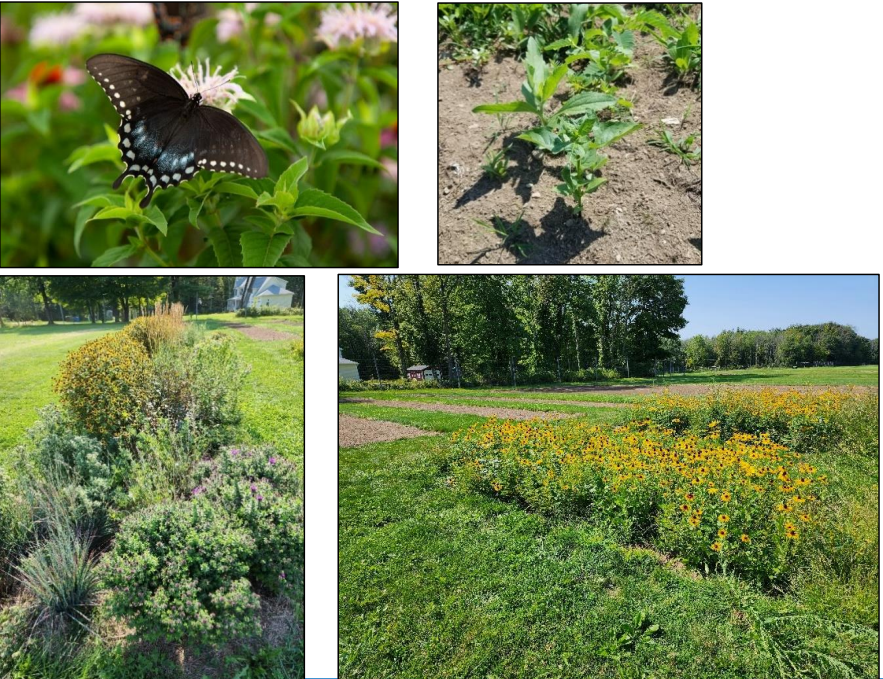
Above right: Seedlings grow in the seeded area.
Below left: The container plants have flourished in the meadow.
Below right: The spring seeded area flowered in summer, while the fall seeded areas remained bare through
summer. Photos: Alyssa Siegel-Miles.
Invasive Species IPM Program
Program Leader: Victoria Wallace, Extension Educator
Invasive Plants: A Growing Concern
IPM methods can be used to control invasive plants in residential properties, communities, and natural and managed landscapes. The Connecticut Invasive Plant Working Group (CIPWG) is a consortium of members of environmental organizations and affiliates of municipal and state agencies whose mission is to promote awareness of invasive plants and their non-invasive alternatives. CIPWG’s news and events list serve has approximately 1250 members. The CIPWG website (cipwg.uconn.edu) provides information on invasive plant identification and management, the Connecticut list of invasive plants, photos, native plant and other non-invasive alternatives, and legislative updates.
CIPWG invasive plant talks were presented, invasive plant educational materials were provided, and/or invasive plant management activities occurred at local, statewide, and regional events during 2022. Over 300 invasive plant activities occurred in over 50 Connecticut towns in 2022. At least 5,017 citizens directly and actively participated in the activities. Many more (at least 7,185) were reached indirectly through articles, YouTube videos, social media, fact sheets, signs, and other educational mediums. A minimum of 15,302 hours were directly invested in invasive plant management, during intensive invasive plant training sessions and management activities, as well as educational outreach. A minimum of 904 hours were provided indirectly as citizens engaged in educational efforts and learned from videos, articles, and fact sheets. During the 2022 calendar year, there were 71,496 page views on the CIPWG website, and 32,000 users participated in 41,000 sessions.
The Eleventh Biennial Connecticut Invasive Plant Working Group (CIPWG) symposium was convened via web program on November 3, 2022, with 420 people attending. The symposium theme was Strategies for Managing Invasive Plants: Assess, Remove, Replace, and Restore. The program was successfully implemented and well received. The all-day event featured regional and local experts as well as citizen volunteers sharing practical solutions
for invasive plant management and actions needed to promote native species and improve wildlife habitat. Symposium information is available on the CIPWG website (cipwg.uconn.edu). 95% of attendees rated the symposium as good to excellent. An article was published in the Newtown Bee about the symposium (Newtownbee.com).

Varricchio. Right: Victoria Wallace moderates a session during the 2022 CIPWG symposium
Comments from course participants
All sessions were highly informative and helpful to stay abreast of current practices and strategies. By offering a great selection of breakout sessions, participants could choose those focusing on their most pressing issues. Most importantly, the quality and expertise of the presenters was outstanding.
The Keynote Speaker was amazing! He provided the scientific evidence for how we can correctly manage invasive species and how to shift our mindset and our methodologies.
I learned a useful approach for controlling the tree of heaven.
Dr. Blossey’s talk was enlightening in terms of what is or is not worth doing to control invasives and protect
natives. It was also interesting to hear about research into various bio-controls. I appreciated all the information provided in session 6.
Invasive Biological Control Projects: Swallowwort
Victoria Wallace serves as the Principal Investigator for a USDA APHIS biological control project of swallowwort, a serious invasive weed of meadows, pastures, roadsides, woodland edges and coastal shorelines. Ms. Wallace supervises the efforts of the research technician who evaluates seasonal feeding damage of the biological control agent (Hypena opulenta) as after release onto dense monocultures of swallowwort in 2022, during the third year of the biocontrol project in CT. A fact sheet and an infographic for swallow-wort biological control are available on the IPM website. The introduction and establishment of biological control agents to reduce populations of swallowwort in CT provide a sustainable method of managing this invasive pest in open spaces throughout Connecticut.
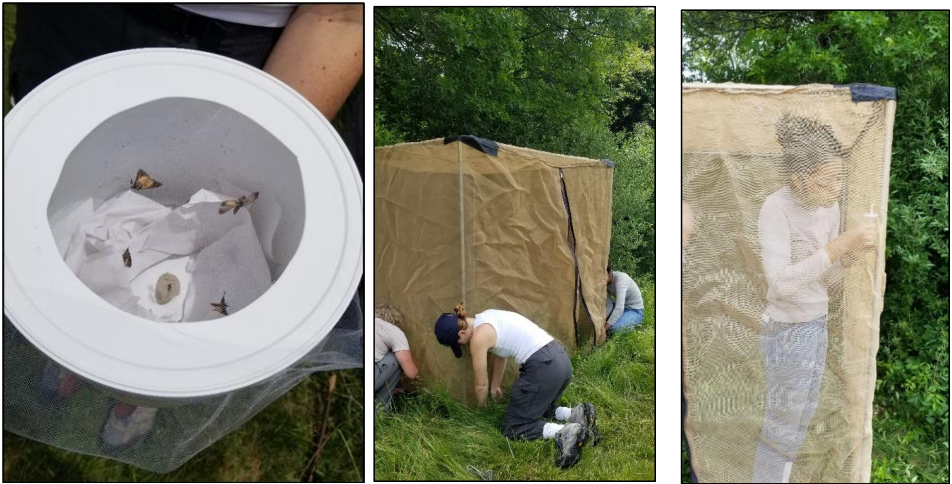
School IPM Program
Program Leader: Victoria Wallace, Extension Educator
The Connecticut School IPM Coalition was formed to support School and Municipal Grounds Managers with turf care and landscape practices following the statewide ban of pesticides on daycare and K-8 school properties. Coalition members develop and present in-person educational workshops for school grounds and athletic field managers and their staff. Assessment tools and recommendations for school grounds and athletic fields that support management practices have been developed.
Schools still were unable to provide locations for a program in summer of 2022. Therefore, the biennial UConn Turfgrass Field Day served as the school IPM program. The day-long program was held on July 28, 2022. Attendees included municipal and grounds managers. The program was attended by over 300 turfgrass professionals who participated in the program, which included research tour stops hosted by UConn turfgrass researchers who share explanations and fielded questions about their current projects. 100% of the attendees who completed the evaluation stated that the information presented during the Turf Field Day would help them make more effective, efficient, and sustainable turf management decisions. 100% of the attendees rated the program good to excellent. 94% of attendees said that the information presented was relevant to their work. An article in UConn Today detailed the event.
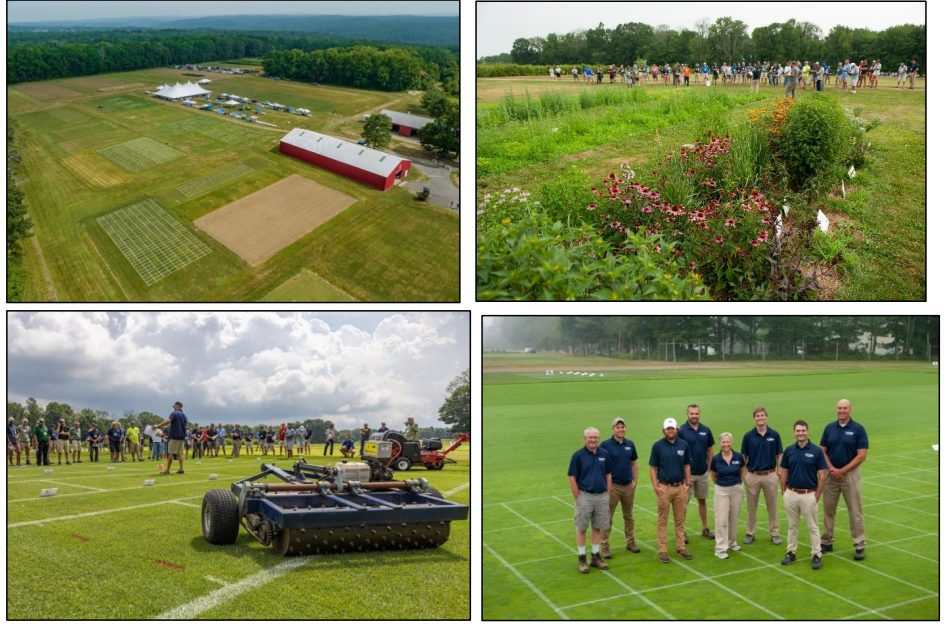
School IPM Program
Program Leader: Victoria Wallace, Extension Educator
The Connecticut School IPM Coalition was formed to support School and Municipal Grounds Managers with turf care and landscape practices following the statewide ban of pesticides on daycare and K-8 school properties. Coalition members develop and present in-person educational workshops for school grounds and athletic field managers and their staff. Assessment tools and recommendations for school grounds and athletic fields that support management practices have been developed.
Schools still were unable to provide locations for a program in summer of 2022. Therefore, the biennial UConn Turfgrass Field Day served as the school IPM program. The day-long program was held on July 28, 2022. Attendees included municipal and grounds managers. The program was attended by over 300 turfgrass professionals who participated in the program, which included research tour stops hosted by UConn turfgrass researchers who share explanations and fielded questions about their current projects. 100% of the attendees who completed the evaluation stated that the information presented during the Turf Field Day would help them make more effective, efficient, and sustainable turf management decisions. 100% of the attendees rated the program good to excellent. 94% of attendees said that the information presented was relevant to their work. An article in UConn Today detailed the event.
We created IPM educational videos in lieu of in-person programming. Turfgrass Faculty involved with the school IPM program, including V. Wallace and Jason Henderson, produced a series of educational videos on School IPM program topics, beginning with cultivation and overseeding as the first topics. Additional videos on fertility and irrigation are in discussion.
Victoria Wallace and Alyssa Siegel-Miles, Research Assistant, continued to produce Extension documents that benefit school ground managers and added them to the IPM website. Substantial work was done to improve the IPM website, including creating web pages for publications completed over the last several years, to make the website more user friendly and accessible.
School and municipal grounds managers, nursery managers, and landscape professionals from 169 CT towns received 8 emails with information, educational materials, and best management practices.
Sustainable Landscapes Program
Program Leader: Victoria Wallace, Extension Educator
Ongoing turfgrass research and evaluation of turfgrass cultivars under low maintenance regimes was conducted. UConn is a cooperator evaluation site for the National Turfgrass Evaluation Program (NTEP) and the Alliance for Low Input Sustainable Turfgrass (A-LIST). Selection of sustainable turfgrass varieties is important for all turfgrass professionals, including turfgrass managers who must manage non-irrigated, pesticide free school athletic fields with a limited budget and few resources. Use of turfgrass seed mixtures of improved cultivars that perform well with fewer inputs is often one of few turf care options for school grounds managers of CT K-8 fields due to the state’s pesticide ban.
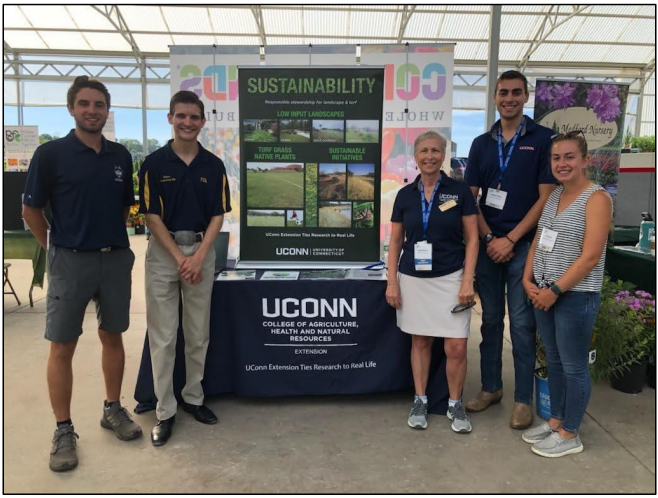
National Turfgrass Evaluation Program
Tall Fescue Test
Year 4 data was collected for a 5-year evaluation trial of turf-type tall fescue cultivars. UConn serves as an evaluation location for this national turfgrass test.
Fineleaf Fescue Test
Year 2 data was collected for a 5-year evaluation trial of fine fescue cultivars. UConn serves as an evaluation location for this national turfgrass test.
Kentucky Bluegrass
Year 5 data was collected for a 5-year evaluation trial of Kentucky bluegrass cultivars. UConn serves as an evaluation location for this national turfgrass test.
Perennial Ryegrass
2022 NTEP Perennial Ryegrass Test was seeded in September 2022.
Alliance for Low Input Sustainable Turfgrass (ALIST) Evaluation
ALIST Fine Fescue Test was seeded in September 2021. Data was collected for 2022 (Year 1) of the fine fescue evaluation trial. UConn serves as a cooperator site for this low input evaluation test.

Conference Programs
Presentations were conducted virtually and in person (nationally, regionally and in state). Victoria Wallace presented at the Sports Field Management Conference, Vermont Greenscape Conference, CT Groundskeepers Fall educational program, the UConn Turfgrass Field Day and the CNLA CANP program. Presentation topics included integrating environmentally sound best practices in athletic field maintenance programs, school grounds manager survey results 10 years after the pesticide ban, using assessments to support management decisions in the landscape, turfgrass selection and establishment after an extensive drought.
Cornell “Short Cutts”
- Wallace serves as UConn representative for a regional turfgrass conference call and newsletter (33-35 weeks/year; April-October), hosted by Cornell Extension faculty. IPM recommendations for turfgrass managers along with current research and weather forecasting were made available to Extension faculty in the Northeast.
Pesticide Safety Education
Program Leader: Victoria Wallace, Extension Educator
Ornamental and Turf Short Course
This Short Course provides an in-depth online educational program that reviews the information necessary to fulfill the requirements of the Ornamental and Turf/Golf Course Superintendents State of Connecticut Supervisory Pesticide Applicator Certification exam. There are 8 modules for this educational program. Class topics are Pesticide Laws and Regulations, Pesticide Safety, Botany and Ornamental Identification, Plant Pathology and Ornamental Plant Diseases, Entomology and Insect Pests of Woody Ornamentals, Area and Dosage Calculations, Turf Management and Weed Management. Each class begins with a basic overview of the science then takes an in-depth look at specific pests, their biology and control. In 2022, the online winter session ran from January-March (58 attendees), and a fall session ran from October-early December (91 attendees). Instructors included: Victoria Wallace, Nick Goltz, Sarah Bailey, and Robert Durgy (CT Agricultural Experiment Station).
Diagnostics
Program Leader: Dr. Nick Goltz, DPM, Assistant Extension Educator
In 2022, the UConn Plant Diagnostic Laboratory (PDL) processed a total of 311 physical samples. Compared to 208 samplesreceived last year (2021), this was an increase of approximately 50%. Additionally, the lab directly responded to at least 350 stakeholder plant health inquires via phone, email, and walk-in. The lab also directly supported the efforts of the UConn Home & Garden Education Center (HGEC), which responded to more than 1,649 additional stakeholder inquiries in 2022.
Sample types submitted this year included agronomic field crops, landscape ornamentals, ornamentals from nurseries and greenhouses, plants grown for the purpose of conducting research, and specialty fruit and vegetables. Samples were accepted from both homeowner and commercial clients from all eight Connecticut counties, as well from several counties in Massachusetts, New York, and Rhode Island.
Diagnostic services rendered included plant disease diagnosis, abiotic disorder diagnosis, plant identification, and insect identification. More than 1,450 diagnostic procedures were performed to arrive at the provided diagnoses. A cost-recovery sample processing fee of $20.00 per sample was covered by this USDA NIFA CPPM grant for samples from Connecticut commercial growers. The submission fee for 93 samples (of 100 budgeted) was covered in this way.
In 2022, Dr. Goltz wrote seven blog posts and five articles for newspapers or online news sites that covered plant health and IPM topics. He presented four modules for the pesticide applicator certification course, five plant pathology classes for the UConn Master Gardener program, and presented as a guest lecturer for three courses taught at UConn. Dr. Goltz gave presentations for the Connecticut Nursery and Landscaping Association (CNLA) 2022 Summer Field Day and the 2022 Connecticut Flower and Garden Show. He also organized an IPM seminar series and presented a talk titled, “Disease Update & IPM Tips for the Home Gardener”. Other talks including “Intro to IPM for Homeowners”, “Lawn Care Tips”, and “Introductory Plant Photography” were presented by staff of the UConn PDL and HGEC at this event.
The UConn Plant Diagnostic Lab is part of the National Plant Diagnostic Network, an internationally recognized consortium of plant diagnostic laboratories funded in part by the USDA National Institute of Food and Agriculture and the US Department of Homeland Security.
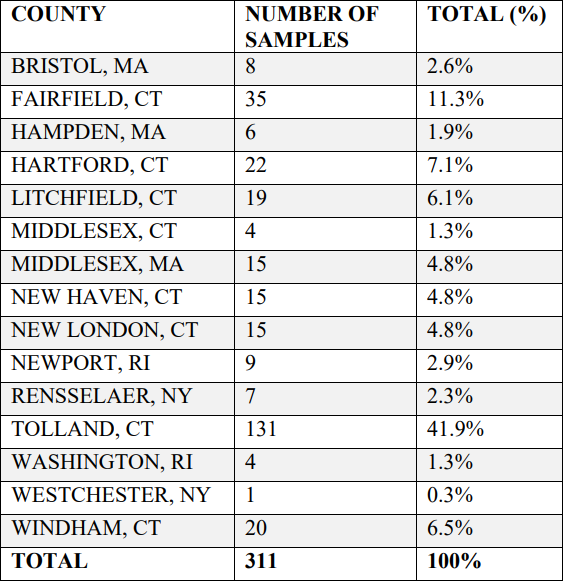
Vegetable Entomology
Program Leader: Dr. Ana Legrand, Assistant Extension Professor
Brassica IPM
Field experiments to evaluate a push-pull system for diamondback moth management in cabbage were successfully completed. Ms. Maussi Arrunategui, graduate student in Dr. Legrand’s lab, established research plots at the Department of Plant Science Research and Teaching Facility to test the effectiveness of a number of potential trap crops to attract the diamondback moth – a key pest of cole crops in Connecticut and around the world. Trap crops attract the pest away from the main crop thus concentrating pest infestations in a smaller area that could be treated or destroyed. Further, a tomato intercrop was tested as a repellent crop against the diamondback moth so that a ‘push-pull’ system can be developed in which the repellent plants complement the trap crops and reduce pest pressure on the crop. Project results indicated the strong potential of glossy collards and red Russian kale as trap crops when planted together with tomatoes as the repellent crop. Further work will examine trap crop placement, density and distance relative to the cash crop. We will also examine the impact on other brassica insect pests.

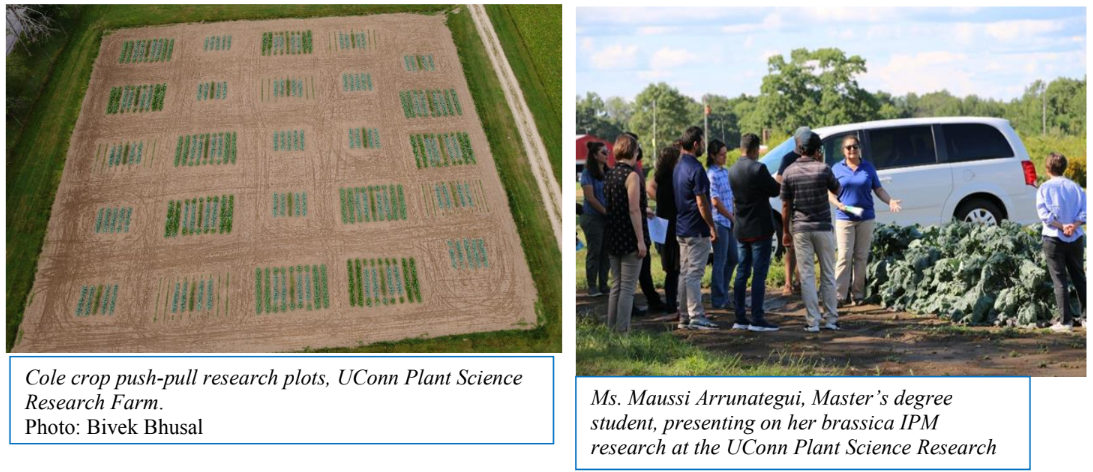
Potato Leafhopper Monitoring & Remote Sensing Project
A multi-disciplinary team at the University of Connecticut continued work to develop a monitoring system for insect pest damage using drones outfitted with spectral sensors. The goal is to detect the presence and early plant damage caused by the potato leafhopper (PLH) on green beans and potatoes. PLH is a significant pest in several horticultural systems, and this work has the potential to benefit multiple commodities through early detection of the insect with minimal labor inputs by growers. Mr. Bivek Bhusal in Ana Legrand’s lab and Ms. Amber Agnew in Chandi Witharana’s lab worked on greenhouse and field experiments to advance this project. The information collected will guide the analysis of bean and potato crop imagery captured by drones. The ultimate goal is to develop a digital scouting tool for PLH feeding damage or for mapping PLH location in a field.
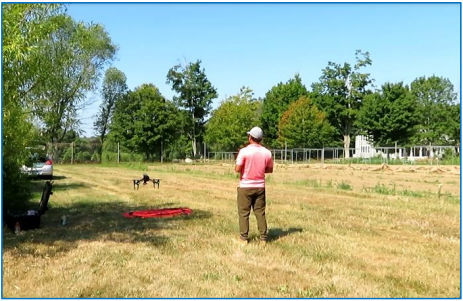
2022 IPM Projects and Publications
Balasubramanian, T. shah, C. Zhu, K. Rankin, S. Ghimire, I. Upadhyaya, and A. Upadhyay 2022. Effect of Ultra-fine ozone bubbles in inactivating Listeria monocytogenes and Salmonella Enteritidis on Romaine lettuce. New England Vegetable and Fruit Conference Proceedings. pp. 224.
Balasubramanian, T. shah, C. Zhu, K. Rankin, S. Ghimire, I. Upadhyaya, and A. Upadhyay. 2022. Application of ultra-fine bubble technology to reduce Listeria monocytogenes contamination of Romaine lettuce. UConn Extension and Department of Plant Science and Landscape Architecture- Crop Talk newsletter 18(3):2-3.
Bonelli, J. and M. Concklin. Crop Insurance and Risk Management Promotion, Education and Training for Connecticut Farmers and Growers 2021-2022. Funding: USDA Risk Management Agency (RMA)
Bonelli, J, and M. Concklin. Risk Management – FSA programs. January 27, 2022. Virtual Bonelli, J, and M. Concklin. Risk Management – Livestock & Dairy Programs. January 26, 2022. Virtual
Bonelli, J, and M. Concklin. Risk Management – Multi-Peril Coverage. February 1, 2022. Virtual Bonelli, J, and M. Concklin. Risk Management – Whole Farm Revenue Coverage. March 3, 2022. Virtual
Bradshaw, T, M. Concklin, H. Faubert, G. Hamilton, E. Garafola. 2022 Virtual Fruit Workshops, weekly January – March 2022
Concklin, M. Spotted Wing Drosophila Update. New England Vegetable & Berry Growers Annual Meeting. Virtual. January 7, 2022.
Concklin, M. Mating Disruption. UConn Crop Talk Newsletter, May 2022, Vol 18, Issue 2, pg. 4
Concklin, M. Drone Imagery for Early Detection of Fruit Crop Nutritional Deficiencies. UConn Crop Talk Newsletter, October 2022 Vol 18, Issue 3, pg. 6
Concklin, M. Editor. 2021 IPM Team Annual report.
Concklin, M. NEERA Annual Meeting – CT IPM Report. Virtual. February 18, 2022
Concklin, M. CAPS meeting. Member. Virtual. March 22, 2022
Concklin, M. Secretary. Northeast Berry Call. Tuesdays, 8 am, April – June 2022
Concklin, M. Drone Imagery for Early Detection of Fruit. Crop Nutritional Deficiencies. Evan Lentz and Nancy Marek, graduate students; Dr. Chandi Witharana and Dept. of Natural Resources and Environment, UConn. Funding: USDA SCBG. 2020-2022
Concklin, M. BMSB Monitoring. Cooperating growers: Belltown Orchards, Blue Hills Orchard, Rogers Orchards. Funding: USDA-NIFA-CPPM grant.
Concklin, M. Fruit IPM – Outreach Programs. USDA NIFA CPPM EIP.
Concklin, M. CT Pomological Society Annual Meeting. November 29, 2022. Program chair
Concklin, M. and V. Wallace. 2022. Sustainable Edible Landscapes. UConn Extension. 8 pp.
Concklin, M., S. Ghimire, N. Goltz, A. Legrand, L. Pundt, R. Raudales, and V. Wallace. 2022. Connecticut Integrated Pest Management Program Annual Report 2021. Univ. of Connecticut, Storrs, CT. 26 pp.
Ghimire, S. and A. Radin. 2022. Soil-biodegradable plastic mulch: Is it right for you? UConn Extension Factsheet. Available at Soil-biodegradable plastic mulch: Is it right for you? | Extension News and Publications
Ghimire, S. 2022. Pest and natural enemy dynamics on reduced-till systems in Connecticut. UConn Extension and Department of Plant Science and Landscape Architecture- Crop Talk newsletter 18(3):10-11.
Ghimire, S. 2022. How long does soil-biodegradable plastic mulch take to degrade in soil? UConn Extension and Department of Plant Science and Landscape Architecture- Crop Talk newsletter 18(1):2-5.
Ghimire, S. 2022. Vegetable IPM – Outreach Programs. USDA NIFA CPPM EIP.
Goltz, N. 2022. 2022 Plant Diagnostics Summary Report. https://plant.lab.uconn.edu/diagnostic-reports/
Griffin, D., S. Ghimire, Y. Yu, E.J. Scheenstra, C.A. Miles, and M. Flury. 2022. In-field degradation of soil biodegradable plastic mulch films in a Mediterranean climate. Science of The Total Environment 806, 150238. https://doi.org/10.1016/j.scitotenv.2021.150238.
Griffin, D., S. Ghimire, Y. Yu, E.J. Scheenstra, C.A. Miles, M. Flury, and S. Shrestha. 2022. In-field biodegradation of soil-biodegradable mulch. Available at https://smallfruits.wsu.edu/plastic-mulches/
Legrand, A and M. Concklin. UConn Subcontract. An Undergraduate Integrated Pest Management (IPM) Training Program for the South and Northeast Regions. USDA AFRI ELI.
Legrand, A. Vegetable IPM – Outreach Programs. USDA NIFA CPPM EIP.
Legrand, A. and C. Witharana. Integrated Systems Research and Development in Automation and Sensors for Sustainability of Specialty Crops. SAES Capacity Grant Program.
Legrand, A. and C. Witharana. Digital scouting for insect pests using unmanned aerial system technology. SAES Capacity Grant Program.
Pundt, L. 2022. Vegetable Transplant Production. https://nevegetable.org/vegetable-transplant-production. New England Vegetable guide printed for distribution at New England Vegetable and Fruit Conference Dec 13, 14 and 15th 2022.
Pundt, L. 2022. Powdery Mildew on Greenhouse Tomatoes. Crop Talk. 18 (11): 2-3.
Pundt, L. 2022. Two-spotted Spider Mite Cleanup. Crop Talk. 18 (3):45.
Pundt, L. 2022. Some Tips on Getting Started Using Biological Control Agents. January 6. 2022. 6 pp.
Pundt, L. 2022. A Few IPM Scouting and Diagnostic Resources for You. January 14, 2022. 4 pp.
Pundt, L. 2022. Steps to Prevent Nutritional Issues on Your Spring Crops. January 19, 2022. 2 pp. f
Pundt, L. 2022. Online IPM Resources for You. January 28, 2022. 2 pp.
Pundt, L. 2022. Tips on Starting Seeds. February 10, 2022. 4 pp.
Pundt, L. 2022. Applying Beneficial Nematodes, Inspecting Incoming Plugs, February 18, 2022. 4 pp. f
Pundt, L. 2022. Online Pesticide Information Resources, February 22, 2022. 3 pp.
Pundt, L. 2022. Bacterial Blight on Geraniums, Fungus Gnats, Botrytis. March 4, 2022. 4 pp.
Pundt, L. 2022. Handling Growing Media, Plugs and Initial Watering. March 11, 2022. 5 pp.
Pundt, L. 2022. Growing Vegetable and Herb Transplants. March 18, 2022. 3 pp.
Pundt, L. 2022. More on Bacterial Blight on Geraniums. March 21, 2022. 6 pp.
Pundt, L. 2022. Aphids, Ghost Spot on Geraniums. March 25, 2022. 3 pp.
Pundt, L. 2022. Calibrachoa Diseases, Aphids, Botrytis. April 1, 2022. 2 pp.
Pundt, L. 2022. Tips to Prevent Spray Damage, Nutritional Monitoring Resources. April 7, 2022. 3 pp.
Pundt, L. 2022. Iron Deficiency. April 14, 2022. 2 pp.
Pundt, L. 2022. Spider Mites and Thrips. April 22, 2022.
Pundt, L. 2022. Lower Greenhouse Temperatures and Preventing Botrytis April 25, 2022.
Pundt, L. 2022. Mini Sachets on Mother’s Day Hanging Baskets. May 2, 2022.
Pundt, L. 2022. Why are my summer squash transplant leaves turning yellow? May 10, 2022
Pundt, L. 2022. Caring for Plants in Retail Settings? May 19, 2022
Pundt, L. 2022. Caring for Garden Mums, June 6, 2022
Pundt, L. 2022. Thrips, Leaf Spots on Zinnia, June 10, 2022
Pundt, L. 2022. Thrips, Plant Leafhoppers, Spider Mites, June 20, 2022
Pundt, L. 2022. Powdery Mildews. June 23, 2022
Pundt, L. 2022. Garden Mums, Downy Mildews on Herbaceous Perennials and Basil, June 29,
Pundt, L. 2022. Potato Leafhoppers, Red Headed Flea Beetles, Four Lined Plant Bugs, July 8
Pundt, L. 2022. Spider Mites, Scarab Beetles, Poinsettia Scouting, July 15, 2022,
Pundt, L. 2022. Root Health of Garden Mums, July 21, 2022
Pundt, L. 2022. Garden Mums: Thrips, drought stress and high salts. July 29, 2022
Pundt, L. 2022. Drought and Heat Stress, Caterpillars on Ornamental Kale & Cabbage, August 4, 2022,
Pundt, L. 2022. Highlights from the Greenhouse Biological Control Conference, August 19, 2022,
Pundt, L. 2022. Poinsettia Scouting Tips, thrips and Whiteflies, August 25, 2022
Pundt, L. 2022. Whiteflies, September 8, 2022
Pundt, L. 2022. Scouting for Whiteflies on Poinsettias, Sept 16, 2022
Pundt, L. 2022. Spider Mite Cleanup, September 28, 2022
Pundt, L. 2022. Testing your Greenhouse Irrigation Water, October 6, 2022
Pundt, L. 2022. Tips on Cleaning your Empty Greenhouses Between Crops, October 21, 2022
Pundt, L. 2022. Preventing Botrytis on Poinsettias, October 27, 2022
Pundt, L. 2022. Poinsettias, Easter Lily Schedule 2023, November 9, 2022
Pundt, L. 2022. Pesticide Storage and Pesticide Record Keeping Requirements, December 2, 2022
Raudales, R., Pundt, L. and Y. Li. 2022. Bacterial Blight on Geraniums, again. E-Gro Alert. 11(19). March 2022. 4 pp.
Pundt, L and R, Raudales. 2022. Vegetable IPM – Outreach Programs. USDA NIFA CPPM EIP.
Scheufele, S., A. Legrand, B. Sideman, F. Zaman, and D. Gilrein. Increasing Grower Adoption of Ecologically based Pest Management Strategies to Improve Quality and Yield of Brassica Crops. NE SARE.
Siegel-Miles, A. and V. Wallace. UConn Turfgrass Field Day. Pollinator Plants and Practical Meadow Management for New England Landscapes. July 28, 2022. 295 attendees.
Wallace, V. 2022 CNLA Winter Symposium Virtual. Planning Committee.
Wallace. 2022. Turfgrass Varietal Trial Evaluations: 2017 NTEP Kentucky bluegrass and 2018 NTEP Tall Fescue Test. Research Summary. In 2022 Turfgrass Field Day Booklet. Storrs, CT
Wallace. 2022. Turfgrass Varietal Trial Evaluations: 2020 NTEP Fine Fescue Test and 2021 A-LIST Fine Fescue Test. Research Summary. In 2022 Turfgrass Field Day Booklet. Storrs, CT
Wallace and A. Siegel-Miles. 2022. Pollinator Plants and Practical Meadow Management for New England Landscapes. Research Summary. In 2022 Turfgrass Field Day Booklet. Storrs, CT
Wallace, V. 2022. Biological Control of Swallowwort (Vincetoxicum nigrum/rossicum) in Connecticut, 2022. Semi-Annual Accomplishment Report. November 30, 2022. 5 pp.
Wallace, V. 2022. CIPWG Annual Accomplishment Report. December 31, 2022. 16 pp. Wallace, V. 2022. Green Industry Outreach Programs. USDA NIFA CPPM EIP.
Wallace, V. and A. Siegel-Miles. 2022. Mulch Mowing and Leaf Management. UConn Extension. 3 pp.
Wallace, V. and A. Siegel-Miles. 2022. Strategies to Minimize Deer Damage on School Grounds. Updated. UConn Extension. 6 pp.
Wallace, V. and A. Siegel-Miles. 2022. Management of Moles in CT School Landscapes. Updated. UConn Extension. 4 pp.
Wallace, V. and A. Siegel-Miles. 2022. Jumping Worms. UConn Extension. 2 pp. s.uconn.edu/UConnJumpingWorm
Wallace, V. and A. Siegel-Miles. 2022. Cemetery Management Assessment Form. UConn Extension. 3 pp.
Wallace, V. and A. Siegel-Miles. 2022. Commercial Property Assessment Form. UConn Extension. Updated. 3 pp.
Wallace, V. and A. Siegel-Miles. 2022. Sustainable Landscaping Tips. UConn Extension. 2 pp.
Wallace, V. and A. Siegel-Miles. 2022. Árbol del cielo (Ailanthus altissima). UConn Extension. (C. Caballero, Trans.) 2 pp.
Henderson, J. and V. Wallace. 2022. Mejores Prácticas de Manejo para campos atléticos de temporada fría y libres de pesticidas, Segunda Edición. University of Connecticut, Storrs, CT. (C. Caballero, Trans.) 23 pp. ipm.uconn.edu. (Originally published 2020)
Wallace, V. and A. Siegel-Miles. 2022. Gusanos Saltadores. UConn Extension. (C. Caballero, Trans.) 2 pp.
Wallace, V. and A. Siegel-Miles. 2022. Manejo de Topos En Connecticut Paisajes Escolares. UConn Extension. (C. Caballero, Trans.) 7 pp.
Wallace, V. and A. Siegel-Miles. 2022. Manejo de Venados. UConn Extension. (C. Caballero, Trans.) 9 pp.
Wallace, V. and A. Siegel-Miles. 2022. Estaciones Metereológicas en Escuelas de Connecticut. UConn Extension. (C. Caballero, Trans.) 5 pp. ipm.uconn.edu. (Originally published 2018)
Wallace, V. and A. Siegel-Miles. 2022. Productos biológicos disponibles para escuelas en Connecticut. UConn Extension. (C. Caballero, Trans.) 3 pp. ipm.uconn.edu. (Originally published 2019)
Wallace, V. and A. Siegel-Miles. 2022. Control biológico para los terrenos escolares en Connecticut. UConn Extension. (C. Caballero, Trans.) 5 pp. ipm.uconn.edu. (Originally published 2019)
Wallace, V. and A. Siegel-Miles. 2022. Guía de Plantas Nativas de Connecticut y Paisajismo Sostenible. UConn Extension. (C. Caballero, Trans.) 44 pp. ipm.uconn.edu. (Originally published 2021)
Wallace, V. 2022. “Climate Change and the Impact of Seed Selection.” Vermont Greenscape Conference. Vermont. Presentation. December 6, 2022. 185 attendees.
Wallace, V. 2022. “After the Drought: Using Assessments to Guide Fall Turf Care Practices.” CT Groundskeepers presentation. Essex, CT. Presentation. September 13, 2022. 40 attendees.
Wallace, V., B. Polimer, and J. Bowers. 2022. “Understanding the Value of STMA’s Best Practices Document.” Sports Field Management Conference. Savannah, GA Presentation. January 18, 2022. 50 attendees.
Wallace, V. and J. Henderson. 2022. “Living with a Legislative Pesticide Ban.” Sports Field Management Conference. Savannah, GA Presentation. January 18, 2022. 95 attendees.
Wallace, V. UConn Turfgrass Field Day. Turfgrass Varietal Trial Evaluations: 2017 NTEP Kentucky bluegrass and 2018 NTEP Tall Fescue Test. July 28, 2022. 295 attendees.
Wallace, V. UConn Turfgrass Field Day. Turfgrass Varietal Trial Evaluations: 2020 NTEP Fine Fescue Test and 2021 A-LIST Fine Fescue Test. July 28, 2022. 295 attendees.
Wallace, V. CNLA Winter Symposium Session. Virtual. Moderator. January 26, 2022. 160 attendees. Wallace, V. “Lawns/Turf Management.” CANP Class November 1, 2022. 51 attendees. Wallace, V. 2022. Cooperative Agricultural Pest Survey (CAPS) Meeting. Virtual. March 22, 2022. 20 attendees.
Wallace. V., J. Henderson, and A. Siegel-Miles. 2021. Turfgrass Health Tips for CT School Grounds Managers: Cultivation. Video. https://youtu.be/v1TZBU4kwgI
Wallace, V. 2022 ECSU SustainableCT Program, Reviewer
Wallace, V. 2022. Invasive Plants Council, Member
Wallace, V. 2022. CT Invasive Plant Working Group (CIPWG). Co-Chair, Steering Committee Member Wallace, V. 2022. CT Invasive Plant Working Group (CIPWG). Co-Chair, Symposium Planning Committee
Wallace, V. 2022. Best Management Practices for New England Sports Turf – Chair of New England Advisory Committee; in progress
Wallace, V. Ornamental & Turf Short Course- 2022 Winter Session – Program Coordinator and Instructor. 58 attendees.
Wallace, V. Ornamental & Turf Short Course- 2022 Fall Session Program Coordinator and Instructor. 91 attendees.
Wallace, V. 2022. Biological Control of Swallowwort (Vincetoxicum nigrum/rossicum) in Connecticut, 2022. Final Report.
Wallace, V. 2022. National Turfgrass Evaluation Program – Tall Fescue Test, Year 4
Wallace, V. 2022. National Turfgrass Evaluation Program – Fine Fescue Test, Year 2
Wallace, V. 2022. National Turfgrass Evaluation Program – Kentucky Bluegrass, Year 5 Wallace, V. 2022. Alliance for Low Input Sustainable Turf – Fine Fescue Test, Year 1
Witharana, C., A. Legrand and S. Ghimire. Early Detection of Potato Leafhopper Damage Using Unmanned Aerial Systems. Northeast IPM Center Partnership Grants.
IPM Program Partners
A number of individuals, organizations, and groups were instrumental in the success of many IPM Program efforts. The UConn IPM Program Team is grateful for their cooperation and assistance. In addition, the IPM Program Team acknowledges the assistance of municipal staff (departments of public works, parks and recreation, conservation commissions, inland wetlands commissions, and Town Mayors/Managers/First Selectman) from many Connecticut towns.
Phil Alligretti, The Plant Group, Inc., North Franklin, CT
American Phytopathological Society, Northeastern Division
Audubon Society of Connecticut
Jason Barnes, Geremia Greenhouses, Wallingford, CT
Nancy Barrett, Scantic Farm, Somers, CT
Chip Beckett, Beckett Farm, Glastonbury, CT
Steve Bengtson, Cold Spring Brook Farm, Berlin, CT
Michaele Williams, Bishop’s Orchards, Guilford, CT
Andrew Brand, Interim Director of Horticulture, Coastal Maine Botanical Garden
Evan Brand, Prides Corner Farms, Lebanon, CT
Richard Calarco, Former Director, Town of Hebron Parks and Recreation Department, Hebron, CT, Advisor Alex Carpenter, Assawaga Farm, Putnam CT
Spencer Cartabiano, Willow Valley Farm, Willington, CT
John Casertano, Phil Sharkey, and Vern Weeda, Casertano’s Greenhouse & Farms, Inc., Cheshire and Wallingford, CT
Jeff Cole, The Carrot Project
The Connecticut Agricultural Experiment Station (Dr. Jatinder Aulakh, Dr. Carole Cheah, Dr. Richard Cowles, Katherine Dugas, Robert Durgy, Dr. Wade Elmer, Rose Hiskes, Dr. Yonghao Li, Dr. Robert Marra, Dr. Victoria Smith, Emmett Varricchio, Dr. Quan Zang)
Connecticut Conference of Municipalities
Connecticut Department of Agriculture
Connecticut Department of Energy and Environmental Protection (DEEP)
Connecticut Environmental Council (CTEC)
Connecticut Farm Bureau
Connecticut Greenhouse Growers Association (CGGA)
Connecticut Grounds Keepers Association (CGKA)
Connecticut Horticultural Society
Connecticut Invasive Plants Council
Connecticut Invasive Plant Working Group (CIPWG)
Connecticut Nursery and Landscape Association (CNLA)
Connecticut Nursery, Christmas tree, orchard, and berry producers participating in commodity surveys
Connecticut Outdoor & Environmental Education Association
Connecticut Pomological Society
Connecticut Recreation & Parks Association (CRPA)
Connecticut River Coastal, Eastern, North Central, Northwest, and Southwest Conservation Districts
Connecticut School Building and Grounds Association
Connecticut School IPM Coalition
Connecticut Tree Protective Association
Silvio O. Conte National Fish & Wildlife Refuge
Cornell University and Cornell Cooperative Extension
Eli Drazen, Drazen Orchards, Cheshire, CT
Andrea Duarte, CT Department of Mental Health, Prevention & Addiction Services
Mark Dwyer, Owner, Landscape Prescriptions by MD
Donny Dzen, Dzen Brothers Farm, East Windsor, CT
Mike Emmons, former director, Prides Corner Farms, Lebanon, CT; advisor Farm Credit East
Greg Foran, Town of Glastonbury, Glastonbury, CT
Hector Gerardo, Seamarron Farmstead, LLC, CT
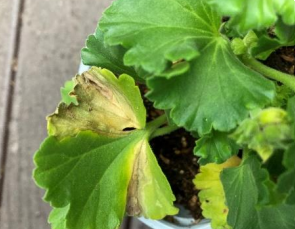
Photo: Leanne Pundt
John and Peter Rogers and Greg Parzych, Rogers Orchards, Southington, CT Rose Mill Company, Hartford, Connecticut
Jeff Sandness, Buell’s Orchard, Eastford, CT
Jerry Savino, Savino Vineyards, Woodbridge, CT
Steve Sawyer, Preston Ridge Vineyards, Preston, CT
Susan Scheufele, UMass Vegetable Program
Linda Schmidt, CT Department of Energy and Environmental Protection
Karen and Tom Scott, Scott’s Yankee Farmer, East Lyme, CT Dr. Becky Sideman, University of New Hampshire
Heather Spade, CT NCSP
Kathy Spielman, CT Pomological Society, Windsor, CT
Peter Stave, Town of Manchester, Manchester, CT
Tom Steen, Steen Consulting, Simsbury, CT
Lisa Stevens, CT Nursery and Landscape Association (CNLA)
Yoko Takemura, Assawaga Farm, Putnam, CT
Dr. Lisa Tewksbury, University of Rhode Island
Tolland County Agricultural Center Trustees
Tolland County Extension Council
John Torello, Bishops Farms, Cheshire, CT
UConn College of Agriculture, Health and Natural Resources: Dr. Indrajeet Chaubey, Dean
UConn Department of Natural Resources and the Environment: John Bartok, Jr., Faculty Emeritus
Dr. Chandi Witharana, Assistant Professor
UConn Department of Plant Science and Landscape Architecture faculty and staff:
- Dr. Mark Brand, Professor
- Dr. Karl Guillard, Professor
- Dr. Jason Henderson, Associate Professor
- Dr. John Inguagiato, Associate Professor
- Evan Lentz, UConn Graduate Student
- Dr. Yi Li, Professor
- Dr. Jessica Lubell-Brand, Associate Professor
- Dr. Richard McAvoy, Professor and Head
- Stephen Olsen, Manager, Farm Services
- Dawn Pettinelli, Assistant Extension Educator
- Steven Rackliffe, Extension Professor
- Dr. Rosa Raudales, Assistant Professor
UConn Extension faculty and staff:
- Joseph Bonelli, Associate Extension Educator
- Bonnie Burr, Assistant Director and Department Head
- Dr. Michael O’Neill, Associate Dean and Associate Director
- Alyssa Siegel-Miles, Program Aide
- Stacey Stearns, Program Specialist 1
UConn Extension Master Gardener Program
UConn Home & Garden Education Center
UConn Plant Diagnostic Laboratory
UConn Plant Science Research and Education Facilities
UConn Soil Nutrient Analysis Laboratory
University of Connecticut
University of Delaware
University of Maine
University of Massachusetts
University of New Hampshire
University of Rhode Island
University of Tennessee
University of Vermont
USDA APHIS: Charles Baker
USDA APHIS: Kate Aitkenhead
USDA Natural Resources Conservation Service (NRCS)
USDA Risk Management Agency (RMA)
Washington State University
Dan Welch, Cornell University
Jim Wells, Monrovia Nursery Company, East Granby, CT
Daniel Wood, Stone Acres Farm, Stonington, CT
Doug Young, Woodstock Orchards, Woodstock, CT
Dr. Faruque Zaman, Cornell Cooperative Extension, Suffolk County